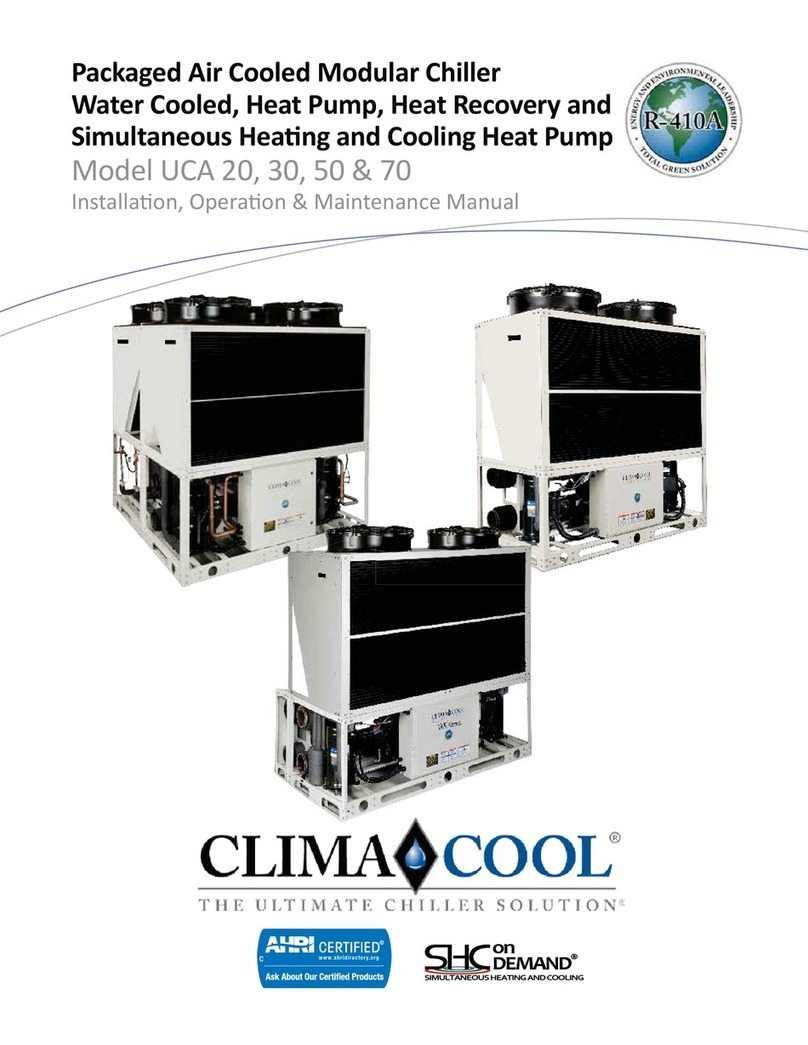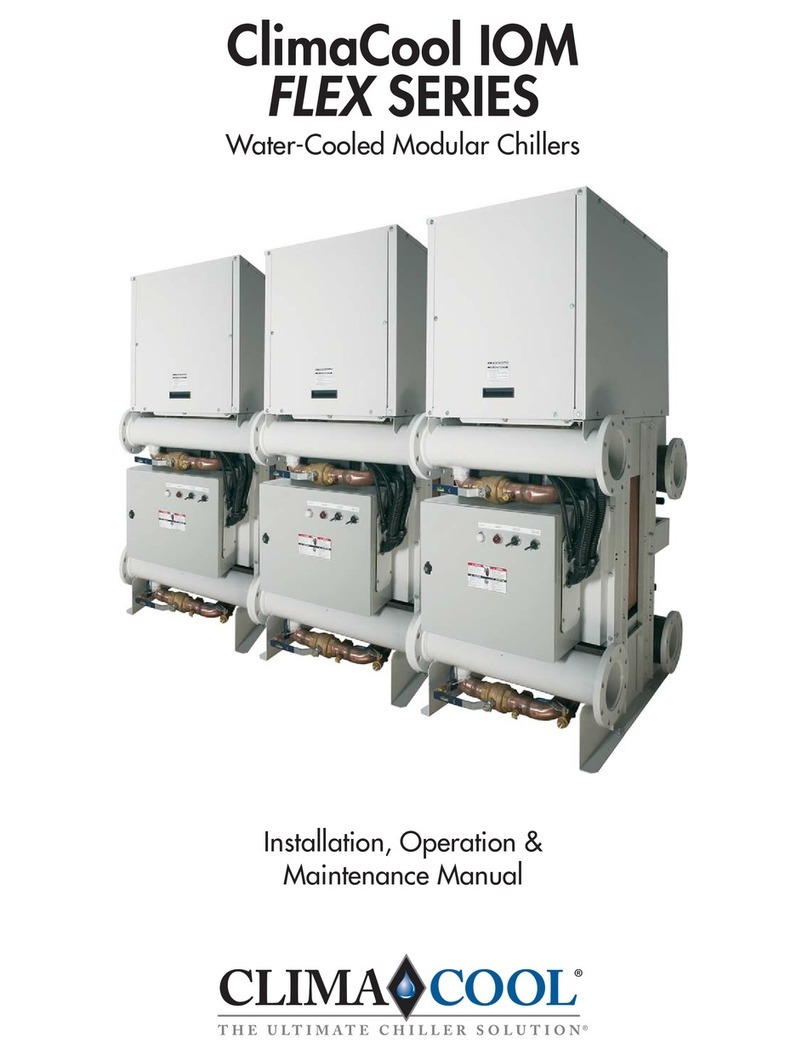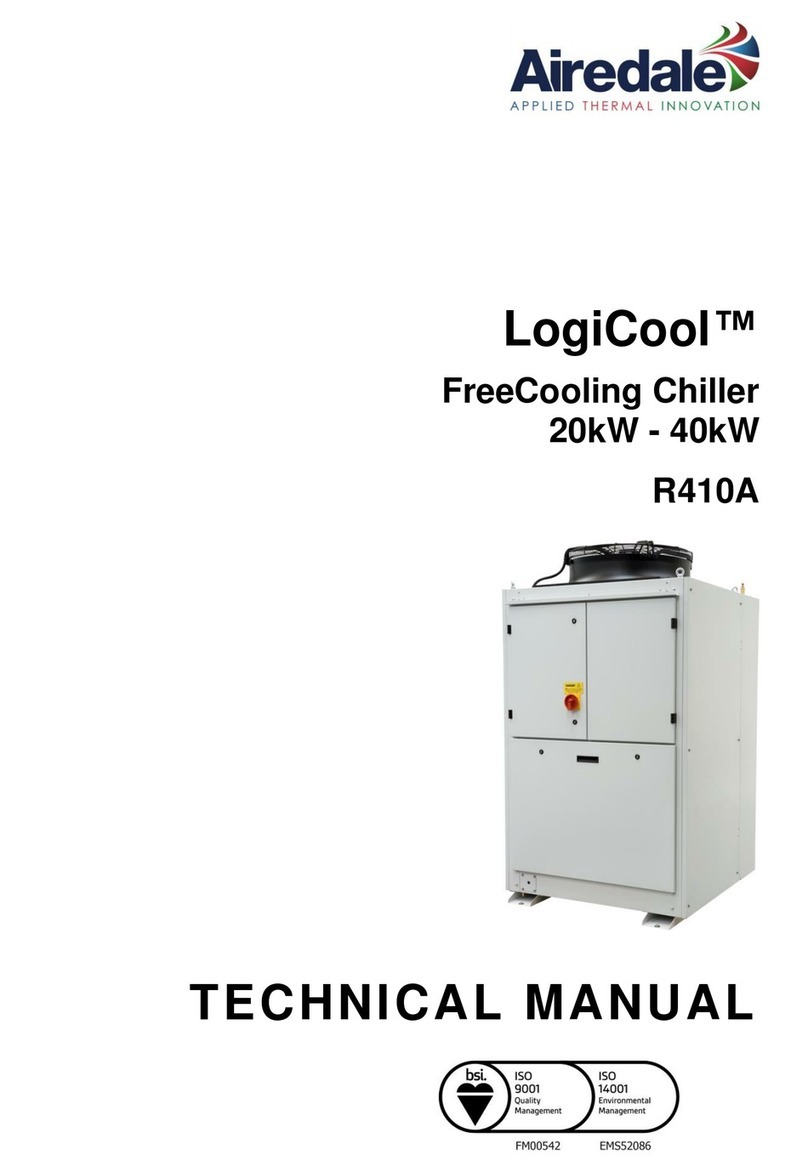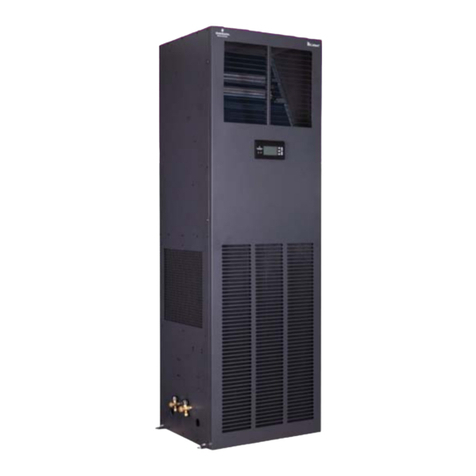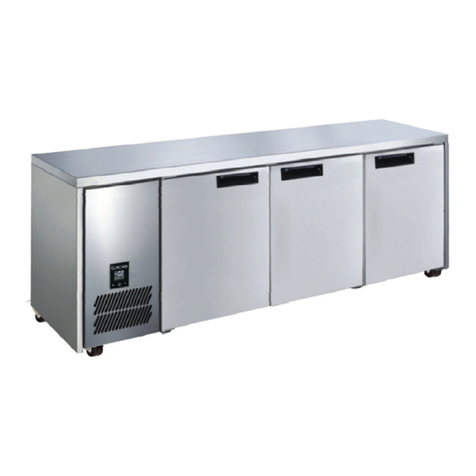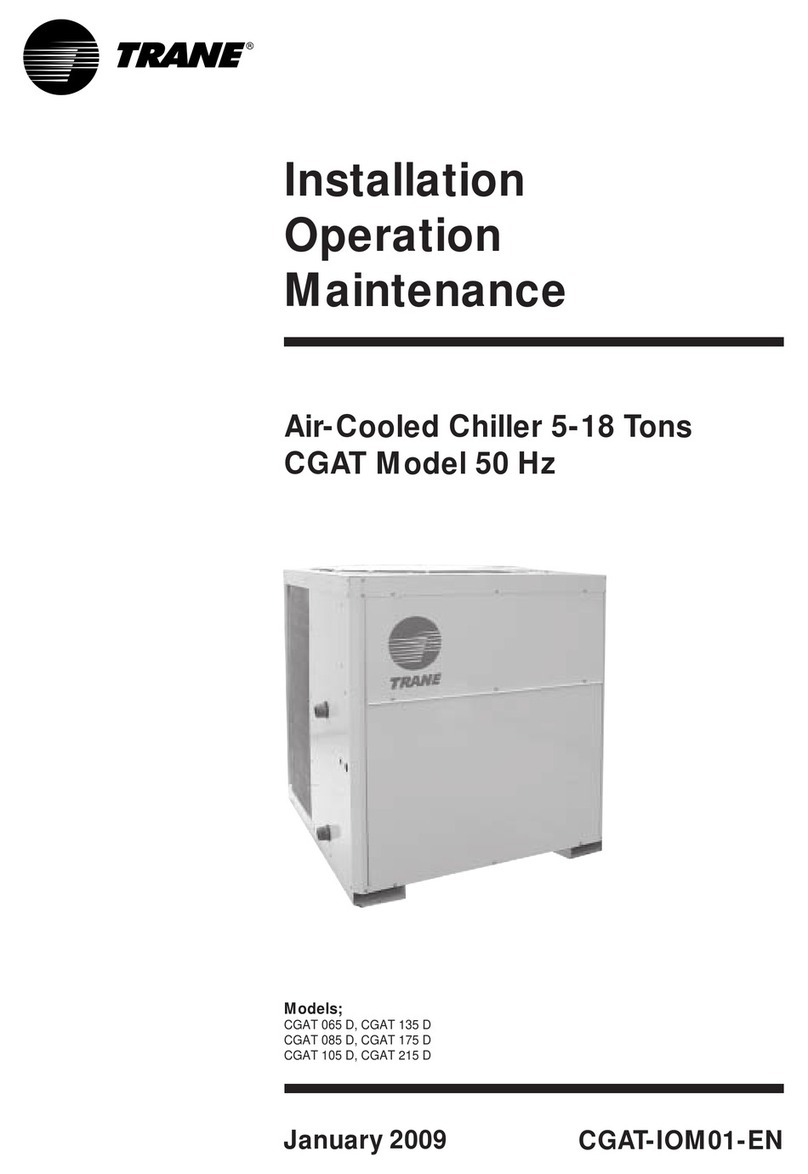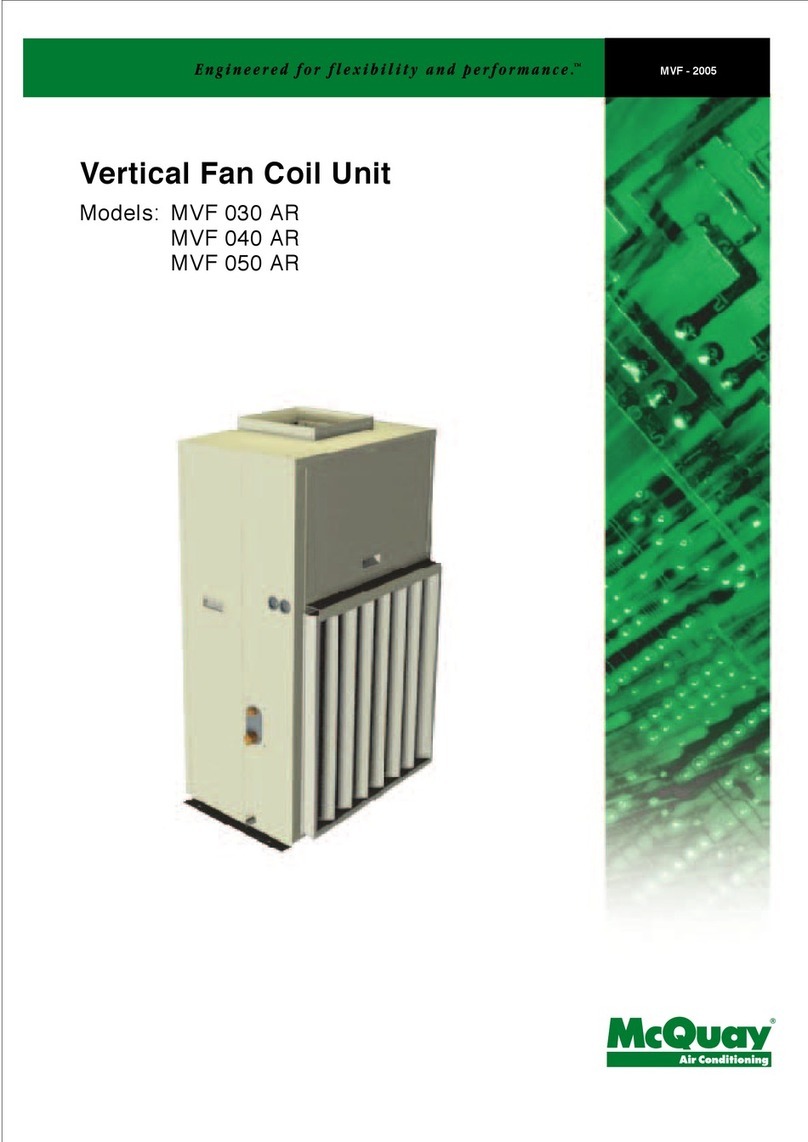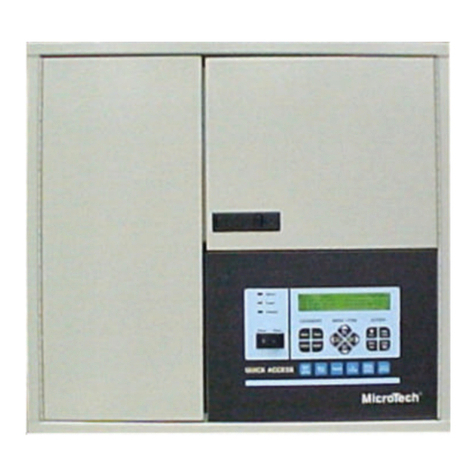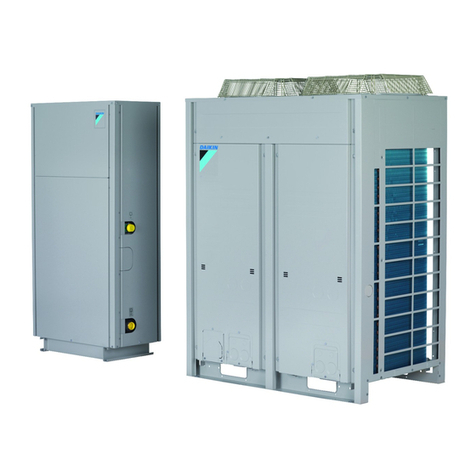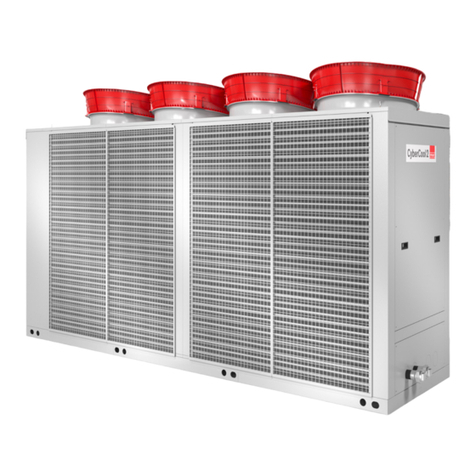ClimaCool UCW 30 Instruction manual

Water Cooled Ulmate Chiller Soluon
Model UCW/H 30, 50, 70, 85
Installaon, Operaon & Maintenance Manual
®

Introduction .........................................1
Pre-Installation .......................................2
Physical Data.........................................3
Dimensional Data and Drawings ........................4
Rigging and Lifting Procedures ........................5
Mounting Rail and Vibration Isolation ...................6
Mounting Holes Locations .............................7
Recommended Service Clearances......................8
Model Key ...........................................9
Unit Installation ...................................10-12
Electrical Connection.................................13
Voltage/Phase Monitor Wiring.........................14
Water Piping ......................................15-16
..........................17
Hydronic Refrigeration ...............................18
Part-Load Performance Advantage ....................19
Filling the Water System..............................20
Water Treatment ....................................21
Water Temperature Requirements ....................22
Condenser & Evaporator Water Pressure Drop Charts ....23
Glycol Performance Adjustment Factors Charts ........ 24-25
Pre-Startup .........................................26
Pre-Startup Check List................................27
Startup..........................................28-29
Superheat & Subcooling Flowchart ....................30
Startup and Warranty Form ...........................31
Chiller Operation and Maintenance ....................32
Heat Exchangers ....................................33
Cleaning Arrangment ................................34
Operational Limitations ..............................35
Compressor Information .............................36
Refrigeration Circuit Diagram ......................37-38
Refrigeration System Re-Processing and Charging .......39
...................40-41
Options and Accessories..............................42
Stainless Steel Strainer Option .....................43-47
WYE Strainers ....................................48-49
Basket Strainers .................................. 50-51
Electrical Data.................................... 52-53
Power Distribution Drawing...........................54
Wiring Diagrams..................................55-64
Troubleshooting Guide ............................65-66
.................................67
Table of Contents

1
®
www.climacoolcorp.com
General Description
ClimaCool’s dedication to energy and environmental
leadership led to the Ultimate Chiller Solution design.
Available in 30, 50, 70 and 85 tons, each module is compact,
and capacity requirements from 30 to 1,000 tons per bank
while having the ability to accommodate future growth and
expansion needs.
heat recovery options utilizing environmentally friendly
R-410A refrigerant for Green building designs.
Safety
Throughout this manual warning, danger, caution and
attention notices appear. Read these items carefully before
attempting any installation, service or troubleshooting of the
equipment. All labels on unit access panels must
be observed.
DANGER: Immediate hazardous situation which, if not
avoided, will result in death or serious injury.
WARNING: Potentially hazardous situation which, if not
avoided, could result in death or serious injury.
CAUTION: Potentially hazardous situation or an unsafe
practice which, if not avoided, could result in minor or
moderate injury or product or property damage.
ATTENTION: Notication of installed, operation or
maintenance information which is important, but not
hazard related.
Introduction
If this unit uses a 3 Phase Scroll
Compressor, the following
instructions MUST BE followed:
• Unit power supply MUST BE
wired in the proper sequence to
avoid damage to the 3 Phase
Scroll Compressor;
• Scroll Compressors with
INCORRECT rotation show the
following characteristics:
- High sound level;
- High suction pressure and
low discharge pressure;
- Low current draw.
• If any of the three above
characteristics exist, swap two of
the three supply wires at the
disconnect and recheck
compressor for incorrect rotation.
Si cet appareil utilise
compresseur scroll 3-Phase, les
instructions suivantes doivent être
suivies:
• L’alimentation de l’appareil doit
être monté dans l’ordre correct
pour éviter endommager le
compresseur scroll 3-Phase
• Compresseurs scroll avec
rotation incorrecte montrent les
caractéristiques suivantes:
- Haut niveau de son;
- Pression d’aspiration élevée
et une faible pression de
décharge;
- Faible ampérage
• Si l’un des trois éléments
mentionnés ci-dessus sont
remplies , échanger deux des
trois lignes électriques alimen
tant la interrupteur de sécurité et
vérier la rotation du
compresseur.
3 PHASE SCROLL
COMPRESSOR UNITS UNITÉ DE COMPRESSEUR
SCROLL 3-PHASE
CAUTION/ATTENTION
WARNING/AVERTISSEMENT
WATER AND REFRIGERANT
SYSTEMS UNDER PRESSURE
• Isolate/Lockout source
and relieve pressure
BEFORE servicing
equipment.
• Failure to relieve pressure
may result in property
damage, serious bodily
injury or death!
EAU ET FRIGORIGÈNE
EQUIPEMENTS SOUS
PRESSION
• Isoler la source / de
verrouillage et de
soulager la pression
avant entretien de l’équi-
pement.
• Le défaut de soulager la
pression peut entraîner
des dommages matériels,
des blessures corporelles
graves ou la mort!
CAUTION/ATTENTION
Excessive Chlorine,
undissolved solids and other
improper water conditions
WILL DAMAGE the internal
heat exchanger & WILL VOID
YOUR WARRANTY!
Chlore excessive, solides non
dissous et les autres impropre
conditions de l’eau,
ENDOMMAGERA l’échangeur
de chaleur interne et
ANNULERA VOTRE
GARANTIE!
Disconnect power supply
(ies) before servicing. Refer
servicing to qualied service
personnel. Electric shock
hazard. May result in injury
or death!
Unit to be serviced by
qualied personnel only.
Refrigerant system under
pressure. Relieve pressure
before using torch. Recover
refrigerant and store or
dispose of properly.
Debrancher avant d’entre-
prendre le dépannage de
l’appareil. Consulter un
réparateur qualie pour le
dépannage. Risque de choc
électrique. Résiltat de mai
dans dommages ou la mort!
Conifer la maintenance à
un technicien qualie. Le
systéme frigorique sous
pression. Décomprimer avant
d’exposer à la amme.
Récuperer le frigorigene et
le stocker ou le détrulre
correctement.
WARNING/AVERTISSEMENT
CAUTION/ATTENTION
Very Hot Water! L’eau Trés Chaude!
WARNING/AVERTISSEMENT
CAUTION/ATTENTION
Use only copper conductors
for eld installed wiring. Unit
terminals are not designed to
accept other types of
conductors.
Utilisez uniquement des
conducteurs en cuivre pour le
câblage. Bornes de l’unité ne
sont pas conçus pour
accepter d’autres types de
conducteurs.
ATTENTION
To avoid the release of refrigerant into the atmosphere, the
refrigerant circuit of this unit must be serviced only by
technicians who meet local, state and federal prociency
requirements.
All refrigerant discharged from this unit must be recovered
WITHOUT EXCEPTION. Technicians must follow industry
accepted guidelines and all local, state and federal statues for
the recovery and disposal of refrigerants.
If a compressor is removed from the unit, system refrigerant
circuit oil will remain in the compressor. To avoid leakage of
compressor oil, the refrigerant lines of the compressor must be
sealed after it is removed.
Do not defeat, cap, add piping to the outlet of the
valve or attempt to change the relief setting.
ATTENTION
CAUTION/ATTENTION
Single wall heat
exchanger, not suitable
for potable water
connection.
Single paroi echangeur,
non approprié pour le
raccordement d'eau
potable.

®
www.climacoolcorp.com
2
Inspection
Upon receipt of equipment, carefully check the shipment
against the bill of lading and inspect each chiller for any
damage incurred during shipment. Thoroughly check for
any visible damage of control panels and electrical
and/or refrigeration components or broken copper lines.
The carrier must make proper notation of any damages or
shortages on all copies of the bill of lading and complete
acceptance of the shipment. Note: It is the responsibility
carrier. In addition, please notify the ClimaCool Customer
Service Department at 405.815.3000 or customerservice@
climacoolcorp.com of all damage immediately.
Storage
Chillers should be stored in an upright position and kept in a
clean, dry area.
Handling of Modules
Carefully remove the module’s packaging. The chiller’s
steel base cutouts provide maneuverability by forklift or
Procedures on page 5). Verify that all header grooved
couplings and mounting hardware kits are on site prior to
connecting the modules. Note: Consult factory for handling
other than in the upright position.
Rigging and Lifting
Each module should be lifted using a pallet jack or fork
lift. If it is necessary to utilize a crane for rigging or lifting,
each module shall be lifted using lifting straps and spreader
Procedures on page 5.
Warranty
To ensure proper equipment longevity, design performance
and reliability, all ClimaCool chillers must be installed,
operated and maintained in accordance with ClimaCool
IO&M manuals. Water quality is of the utmost importance
for the proper care and maintenance of your modular
chiller system. Regular treatment of the water will increase
longevity of your system. Failure to provide adequate
ltration or treatment of evaporator and condenser
water will void the ClimaCool module’s warranty. A
factory authorized technician is required to perform
the startup of your ClimaCool chiller. Please contact the
ClimaCool Customer Service Department at 405-815-3000 or
a minimum of three (3) weeks notice required to schedule
your factory startup.
Pre-Installation

3
®
www.climacoolcorp.com
Physical Data
Model UCW/H Module and Compressor 30 50 70 85
Capacity (tons) ¹31.7 51.5 67.2 82.8
kW/Ton 0.738 0.746 0.744 0.740
Full-Load EER 2
16.3 16.1 16.1 16.2
Refrigerant Circuits (quantity) 2 2 2 2
Compressor Type Scroll Scroll Scroll Scroll
Compressor Quantity 2 2 2 2
Compressor Nominal Hp (per circuit) 15 25 35 40
Refrigerant Charge R-410A (lbs) 30 55 60 80
Module Operating Weight w/Water (lbs) 3
1565 2405 2515 3075
Module Shipping Weight (lbs)
4
1375 2085 2195 2610
30 50 70 85
Heat Exchanger (type) Brazed Plate Brazed Plate Brazed Plate Brazed Plate
Independent Refrigerant Circuits (quantity) 2 2 2 2
Water Storage Volume HX Only (gals) 3.2 6.1 7.3 11.4
Water Storage Volume HX Plus Main Headers (gals) 13.1 16.7 17.9 26.2
Maximum Design Working Pressure - Water Side (psi) 300 300 300 300
Header Water Connections - Inlet/Outlet (inches)
5
6 6 6 8
30 50 70 85
Heat Exchanger (type) Brazed Plate Brazed Plate Brazed Plate Brazed Plate
Independent Refrigerant Circuits (quantity) 2 2 2 2
Water Storage Volume HX Only (gals) 2.8 5.1 6.5 9.7
Water Storage Volume HX Plus 6" Main Headers (gals) 12.8 15.7 17.1 24.5
System Volume (gals) 6Min
180 300 420 510
Maximum Design Working Pressure - Water Side (psi) 300 300 300 300
Header Water Connections - Inlet/Outlet (inches) 56 6 6 8
Notes:
1.
2.
3.
4. Unit shipping weight includes refrigerant charge, compressor oil and packaging.
5.
6. Required to provide stable operation. Storage/buffer tanks in return piping may be utilized to meet the minimum volume requirements.
7.
85 ton module cannot be directly coupled with 30, 50 or 70 ton modules due to a difference in header and frame size.
Module operational weight includes water, compressor oil, and refrigerant charge. Multiply times the number of modules for a total system
operational weight.
Tonnage ratings conditions: 44°F leaving chilled water temperature, 85°F entering condenser water temperature, flow rates are 3 gpm per ton
through the condenser with a fouling factor of .00025 hr-ft2-°F/Btu and 2.4 gpm per ton through the evaporator with a .0001 hr-ft2-°F/Btu fouling
factor.
Ratings in accordance with AHRI Standard 550/590.
Model UCW/H Condenser
Model UCW/H Evaporator
Main header water/fluid connections are 6" grooved coupling for the 30, 50 and 70 ton modules. The 85 ton module uses 8" grooved couplings.
Model UCW/H Module and Compressor 30 50 70 85
Capacity (tons) ¹31.7 51.5 67.2 82.8
kW/Ton 0.738 0.746 0.744 0.740
Full-Load EER 2
16.3 16.1 16.1 16.2
Refrigerant Circuits (quantity) 2 2 2 2
Compressor Type Scroll Scroll Scroll Scroll
Compressor Quantity 2 2 2 2
Compressor Nominal Hp (per circuit) 15 25 35 40
Refrigerant Charge R-410A (lbs) 30 55 60 80
Module Operating Weight w/Water (lbs) 3
1565 2405 2515 3075
Module Shipping Weight (lbs)
4
1375 2085 2195 2610
30 50 70 85
Heat Exchanger (type) Brazed Plate Brazed Plate Brazed Plate Brazed Plate
Independent Refrigerant Circuits (quantity) 2 2 2 2
Water Storage Volume HX Only (gals) 3.2 6.1 7.3 11.4
Water Storage Volume HX Plus Main Headers (gals) 13.1 16.7 17.9 26.2
Maximum Design Working Pressure - Water Side (psi) 300 300 300 300
Header Water Connections - Inlet/Outlet (inches)
5
6 6 6 8
30 50 70 85
Heat Exchanger (type) Brazed Plate Brazed Plate Brazed Plate Brazed Plate
Independent Refrigerant Circuits (quantity) 2 2 2 2
Water Storage Volume HX Only (gals) 2.8 5.1 6.5 9.7
Water Storage Volume HX Plus 6" Main Headers (gals) 12.8 15.7 17.1 24.5
System Volume (gals) 6Min
180 300 420 510
Maximum Design Working Pressure - Water Side (psi) 300 300 300 300
Header Water Connections - Inlet/Outlet (inches) 56 6 6 8
Notes:
1.
2.
3.
4. Unit shipping weight includes refrigerant charge, compressor oil and packaging.
5.
6. Required to provide stable operation. Storage/buffer tanks in return piping may be utilized to meet the minimum volume requirements.
7.
85 ton module cannot be directly coupled with 30, 50 or 70 ton modules due to a difference in header and frame size.
Module operational weight includes water, compressor oil, and refrigerant charge. Multiply times the number of modules for a total system
operational weight.
Tonnage ratings conditions: 44°F leaving chilled water temperature, 85°F entering condenser water temperature, flow rates are 3 gpm per ton
through the condenser with a fouling factor of .00025 hr-ft2-°F/Btu and 2.4 gpm per ton through the evaporator with a .0001 hr-ft2-°F/Btu fouling
factor.
Ratings in accordance with AHRI Standard 550/590.
Model UCW/H Condenser
Model UCW/H Evaporator
Main header water/fluid connections are 6" grooved coupling for the 30, 50 and 70 ton modules. The 85 ton module uses 8" grooved couplings.

®
www.climacoolcorp.com
4
Dimensional Data and Drawings
LOAD WATER PIPING CONFIGURATION ARRANGEMENT (HEADER “A”)
UCW UCH HEAT RECOVERY UCH HEAT PUMP
(Cooling Priority)
UCH HEAT PUMP
(Heating Priority)
CHILLED WATER OUTLET CHILLED WATER OUTLET LOAD WATER OUTLET LOAD WATER INLET
LOAD WATER PIPING CONFIGURATION ARRANGEMENT (HEADER “B”)
UCW UCH HEAT RECOVERY UCH HEAT PUMP
(Cooling Priority)
UCH HEAT PUMP
(Heating Priority)
CHILLED WATER INLET CHILLED WATER INLET LOAD WATER INLET LOAD WATER OUTLET
Model
UCW/H Voltage
A
Unit
Width
(in.)
B
Unit
Height
(in.)
C
Header
Width
(in.)
D
Unit
Depth
(in.)
E
Header
Location
F
Header
Location
G
Header
Location
H
Header
Location
I
Header
Location
J
Header
Location
K
Header
Location
Header
Connection
(in.)1
030 208/230/460/575/3/60 34 19 58 58 6
050 208/230/460/575/3/60 34 19 58 58 6
070 208/230/460/575/3/60 34 19 58 58 6
085 208/230/460/575/3/60 34 72 67 48 8
UNIT DIMENSIONS (IN INCHES)
Note:

5
®
www.climacoolcorp.com
Rigging
Each module should be lifted using lift straps threaded through the steel base cutouts and a spreader bar.
Note: If no spreader bar is used, damage to the module may occur.
Figure 1 Figure 2
Lifting Strap Lifting Strap
Spreader BarSpreader Bar
Spreader Bar
Figure 1 Figure 2
Figure 3
Lifting and Transporting Modules
Pallet jacks or forklifts are required for lifting and transporting the module. Each module has base cutouts provided for ease
of maneuverability. 60” forks are recommended to prevent damage to chiller base.
Rigging and Lifting Procedures

®
www.climacoolcorp.com
6
bolt holes provided in each base pan. Use bolts with a maximum diameter < 0.6”; length to be dependent on customer
mechanical layout. See Base Pan top view drawing on the next page.
Due to the low vibration of the modules, the application of spring isolators or pads is not required. Should isolators or
pads be desired install in accordance with Figures 4 and 5.
Figure 4 - Spring Vibration Isolators Option
4” Rail Minimum
Recommended
(by others)
Spring Vibration
Isolators (by others)
4” Rail Minimum
Recommended
(by others)
4” Rail Minimum
Recommended
(by others)
Spring Vibration
Isolators (by others)
4” Rail Minimum
Recommended
(by others)
Note:
Figure 5 – Vibration Isolation Pads Option
Mounting Rail and Vibration Isolation

7
®
www.climacoolcorp.com
Mounting Holes
Top View of UC*085 Base Pan Shown —Front of Unit
33.675
The six mounting hole locations are circled in red.
Dimensions are shown in inches.
Top View of UC*030, 050, and 700 Base Pan Shown — Front of Unit
33.675

®
www.climacoolcorp.com
8
Recommended Service Clearances
Notes:
1. Allow 36" clearance for electrical panels and 30" clearance for rear service access to modules.
2. Allow a minimum of 18" height clearance for 30, 50 and 70 ton modules. Allow a minimum of 24” height clearance for 85 ton modules.
3. Local building and/or electrical codes may require additional clearance. Consult applicable codes.
CoolLogic
Control Panel
(Wall Mounted)
Top View
Rear Service Access
Front Service Access
36”
36”
30”
30”
12”

9
®
www.climacoolcorp.com
RejectionMeans
H=HighTemperature
ModelConfiguration
W=WaterE=SeismicCertification(030,050&070ton,WaterCooledonly)
S=Standard
X=SpecialOptions
NominalTons
015
RefrigerantOptions
025 0=(None)
030 B=HotGasBypass‐BothCircuits
050 (NotavailablewithHeatPumpapplication)
070 P=HotGasBypasswithPressureReliefValves
085 R=PressureReliefValves(standardforallUCR's)
X=SpecialOptions
DesignSeries WaterIsolationValves
A0=(None)
B=Evaporator&CondenserMotorizedValves
C=EvaporatorManualValves&MotorizedCondenserValves
Voltage
E=EvaporatorMotorizedValves&ManualCondenserValves
F=460/3/60 (lessManualCondenserValvesforAirCooled)
H=208‐230/3/60 M=ManualValvesforEvap&Condsr
N=575/03/60 (lessManualCondenserValvesforAirCooled)
U=380/3/50 X=SpecialOptions
Application
Controls&Electrical
C=Cooling
A=StandardControls H=HeatRecovery
S=SingleModuleControls R=ReverseCycle(HeatPump)
T=SingleModuleControlswithLonWorks X=SpecialOptions
X=SpecialOptions
Refrigerant
A=R‐410A
CompressorType
B=R‐134a(Forusewithhotwatertemperatures≥140°,notavailablein85ton)
S=Scroll X=SpecialOptions
X=SpecialOptions
₁₂
UC F S
₈₄₅₆ ₇ ₉ ₁₀
030
UltimateChillerSolutionModelKey
₁₅
W ASACA
₃₁₃ ₁₄
M0
₁₂₁₁
Model Key

®
www.climacoolcorp.com
10
Unit Placement
ClimaCool modular chillers must be installed in a conditioned
requirement for the chiller is a level surface capable of bearing
the combined operating weight of the modules
Service Access
The recommended service clearances are 36” for front
access, 18” height clearance for 30, 50 and 70 ton modules,
and 24” height clearance for 85 ton module, 30” for rear
access and at least 12” for side clearance or as required
on page 7). Local building or electrical codes may require
additional clearance – please consult applicable codes.
Draining
When performing standard maintenance procedures such
optional water isolation valves for this purpose. Access to a
procedures. Warning: Water valves must be reopened after
ushing is complete.
Assembling Modules
ClimaCool recommends locking down the chiller to a
the compressors are installed on anti-vibration mountings,
further isolation of the chiller from the structure is
recommended by installing vibration-eliminating springs
or pads under the base rails on which the chiller will rest
module should be chosen as the reference module and
carefully located.
Field installed mounting accessories are provided for
adjoining each module.
•
grooved couplings with gaskets
• Mounting hardware kit containing necessary bolts,
spacers, nuts and washers
•
Field installing the mounting hardware kit will assist with
sides of the unit base pan. First module should be set, set
adjacent unit on mounting surface roughly aligned 1½ inches
and insert bolt through front mounting hole and spacer.
Repeat the process for the rear mounting hole. Line up
mounting hole of adjacent module with bolt from previous
module and working through adjacent modules front base
cutout place a washer, split lock washer and nut. Using the
appropriate tools tighten hardware assembly until seated.
Inspect the pipe ends to ensure they are free from any
indentations, projections, roll marks or other harmful surface
defects such as loose paint, scale, dirt, chips, grease and rust.
Inspect the grooved coupling gasket for any defects. Apply
a thin layer of silicone or other non-petroleum lubricant to
the sealing lips of the gasket as well as to the exterior of the
gasket. Install gaskets on the pipe ends of one of the two
modules to be mated. Be sure the gasket is completely on
the pipe to avoid damage in the next step. Move the second
module into position and line up the piping. Ensure you are
maintaining alignment for any additional modules to be
added. When pipe ends are aligned, slide the gasket over
the ends and center it between the grooves. No part of the
gasket should protrude into the groove of either pipe end.
Place the coupling halves over the gasket and make sure that
engaged into the grooves. Insert the bolts and install nuts to
hand tight. Ensure the oval neck of the bolt engages into the
bolt hole of the housing. Tighten nuts alternately and equally
until the bolt pads meet and make metal to metal contact.
Tighten nuts by another ¼ to ½ turn to make sure the nuts
and bolts are snug and secure; the use of a torque wrench
is usually not required. Uneven tightening of bolts may
cause the gasket to be pinched resulting in immediate
or delayed leaks.
Header Insulation
Chilled water piping is pre-insulated on each module at the
cell insulation. After bolting all modules together and leak
testing, the entire coupling connection will need to be
insulated by the installing contractor.
Unit Installation
Figure 6: Mounting Hardware Kit

11
®
www.climacoolcorp.com
Unit Installation
Figure 8: Gasket Installation Between Modules
Figure 7: Header Insulation
Front Back
Grooved Couplings Installation
Inspect the pipe ends to ensure they are free from any
indentations, projections, roll marks, or other harmful
surface defects such as loose paint, scale, dirt, chips,
grease and rust. Inspect the grooved coupling gasket for
any defects. Grooved couplings are used to adjoin a bank
of modules. This requires the temporary removal of all
top, back and side sheet metal panels to obtain additional
couplings can be installed using the following recommended
instructions:
Figure 9 - UCW/H Side View
31
2
4
Figure 10
Figure 11
• Remove the rubber gasket from the coupling.
• Apply a thin layer of silicone or other non-petroleum
lubricant to both the inner and outer surface of the
gasket to reduce friction.
• Slide the gaskets on the headers as shown in Figure 10.
• Be sure the gasket is completely on the pipe to
eliminate any damage to the gasket.
• With gasket in place on each header of the positioned
position and line up the piping. Ensure alignment is
maintained for any additional modules to be added.
Sound Attenuation Panels and Gasket
Attenuation panels are enclosures made of 18 gauge
for installation between modules. Install panels by setting
in place and locking down with the half turn latches or
self tapping screws. Note: Panel package includes a
compressed 1” x 1” gasket sealant tape for installation
between modules. Install the tape on the outer frame
on the side of one module prior to installing the adjacent
modules. See Figure 8.
• Review Figure 9, UCW/H Side View below.
• Headers are numbered indicating the easiest order of
coupling installation.
• UCW/H chillers should have couplings installed on
headers 1, 4 from the top and 2, 3 from the
back of the unit.

®
www.climacoolcorp.com
12
Unit Installation
Figure 12
Figure 13
• Open the coupling by completely removing one bolt
• -
ing the coupling intact.
• Install with the nuts facing up for fastening.
• When the pipes ends are aligned, slide the gasket over
the ends and center it between the grooves.
• No part of the gasket should protrude into the groove
of either pipe end.
• Place coupling halves over the gasket and make sure
groove), are engaged into the grooves.
• Insert the previously removed bolt from the bottom to
• Tighten nuts alternately and equally until the bolt pads
meet and make metal-to-metal contact.
• Tighten nuts by another ¼ to ½ turn to make sure the
nuts and bolts are snug and secure, the use of a torque
wrench is usually not required.
• Uneven tightening of bolts may cause the gasket to be
pinched resulting in immediate or delayed leaks.
• Replace all sheet metal panels.

13
®
www.climacoolcorp.com
The power for all modules is taken from a suitable circuit
breaker/fused disconnect power supply within the main
panel. The electrical service enters the individual modules
through the top into the module’s control panel enclosure.
Proper grounding of the module is mandatory. Before
supply is isolated. A typical power wiring is located on page
47 – Power Distribution Drawing. Knockout drawings are
provided. Do not drill into cabinet; shavings can damage
electronic components. The power for all individual modules
shall be in compliance with all local and national codes.
CoolLogic Control System Wiring
A separate 115 volt power supply is required to power the
CoolLogic Master Control Panel. Communication between
the Master Control Panel and chiller modules requires a
simple two-conductor 18 AWG shielded cable rated at 60°C
minimum, daisy chain connection. Control wiring cannot be
installed in the same conduit as line voltage wiring or with
wires that switch highly inductive loads such as contactor
and relay coils. Refer to the Power Distribution Drawing on
page 47 of this manual for more information. All wiring shall
be in compliance with all local and national codes.
Electrical Phase Sequencing
Proper clockwise rotation for scroll compressor motors
is important to prevent damage to the compressors.
ClimaCool recommends the use of a phase sequence
indicating instrument following the manufactures
directions. An alternative is to “bump test” the compressors
one at a time with pressure gauges attached to the high and
low gauge ports of the compressors to check for proper
rotation. Energize the compressor for a few seconds to
If the discharge pressure does not increase, proper
rotation is reversed. Compressor rotation can be reversed
by opening the main electrical disconnect and switching
any two of the main power supply leads feeding that
compressor’s contactor.
Proper Voltage Balance
Occasionally, in three phase circuits, a voltage imbalance
occurs between phases. It is not recommended to operate
equipment when an imbalance greater that 2% occurs. This
their longevity. The following example describes how to
calculate the average voltage of the three phases to see if
the imbalance is greater than 2%.
Example: Line 1 = 226v Line 2 = 230v Line 3 = 228v
The voltage imbalance of the three phase circuit is 0.9%.
This is well under the 2% range.
Voltage/Phase Monitor
installation with the CoolLogic Master Control Panel.
The voltage/phase monitor helps guard the chiller bank
conditions which could void your warranty. The voltage/
phase monitor has three wires that connect to the main
three phase power chiller bank input. Two low voltage
control wires are connected to the CoolLogic Master Control
Panel. Do not install control wiring in the same conduit
as line voltage wiring or with wires that switch highly
inductive loads such as contactor and relay coils. Note: It
is mandatory to install one (1) monitor per bank at main
power distribution panel to monitor voltage and phasing of
power to the modules. See Wiring Diagram on page 13.
Electrical Connection
CAUTION/ATTENTION
Use only copper conductors
for eld installed wiring. Unit
terminals are not designed to
accept other types of
conductors.
Utilisez uniquement des
conducteurs en cuivre pour le
câblage. Bornes de l’unité ne
sont pas conçus pour
accepter d’autres types de
conducteurs.
If this unit uses a 3 Phase Scroll
Compressor, the following
instructions MUST BE followed:
• Unit power supply MUST BE
wired in the proper sequence to
avoid damage to the 3 Phase
Scroll Compressor;
• Scroll Compressors with
INCORRECT rotation show the
following characteristics:
- High sound level;
- High suction pressure and
low discharge pressure;
- Low current draw.
• If any of the three above
characteristics exist, swap two of
the three supply wires at the
disconnect and recheck
compressor for incorrect rotation.
Si cet appareil utilise
compresseur scroll 3-Phase, les
instructions suivantes doivent être
suivies:
• L’alimentation de l’appareil doit
être monté dans l’ordre correct
pour éviter endommager le
compresseur scroll 3-Phase
• Compresseurs scroll avec
rotation incorrecte montrent les
caractéristiques suivantes:
- Haut niveau de son;
- Pression d’aspiration élevée
et une faible pression de
décharge;
- Faible ampérage
• Si l’un des trois éléments
mentionnés ci-dessus sont
remplies , échanger deux des
trois lignes électriques alimen
tant la interrupteur de sécurité et
vérier la rotation du
compresseur.
3 PHASE SCROLL
COMPRESSOR UNITS UNITÉ DE COMPRESSEUR
SCROLL 3-PHASE
CAUTION/ATTENTION
Disconnect power supply
(ies) before servicing. Refer
servicing to qualied service
personnel. Electric shock
hazard. May result in injury
or death!
Unit to be serviced by
qualied personnel only.
Refrigerant system under
pressure. Relieve pressure
before using torch. Recover
refrigerant and store or
dispose of properly.
Debrancher avant d’entre-
prendre le dépannage de
l’appareil. Consulter un
réparateur qualie pour le
dépannage. Risque de choc
électrique. Résiltat de mai
dans dommages ou la mort!
Conifer la maintenance à
un technicien qualie. Le
systéme frigorique sous
pression. Décomprimer avant
d’exposer à la amme.
Récuperer le frigorigene et
le stocker ou le détrulre
correctement.
WARNING/AVERTISSEMENT
CAUTION/ATTENTION

®
www.climacoolcorp.com
14
Voltage/Phase Monitor Wiring

15
®
www.climacoolcorp.com
As with any water system, it is important that the system
be clean. The pipe work installer must remove weld scale,
rust and contamination during pipe work fabrication.
are compatible with 316 stainless steel, prior to making
connections to the ClimaCool chiller. There are certain
necessary components that should always be installed in
found on pages 15. All water piping must be installed in
accordance with applicable codes and standards.
Temperature Sensor and Wells
with each chiller system programmed by the CoolLogic
36” but no more than 60” away from the bank and before
the strainer, on the chilled water inlet, chilled water outlet,
Note: Sensors must
be fully inserted into the well to obtain proper readings
and must be 2 ½ pipe diameter minimum before or after
an elbow. See Figures 14 and 15.
Chiller/Heater System Water Header Bypass
A bypass is required for any chilled water/evaporator, hot
variable pumping. The bypass must be piped in such a way
Water Piping
Pressure Dierential Flow Sensor
page 31, are not exceeded. To prevent operation of the
sensors in both the chilled and condenser water circuits.
the inlet and outlet of a straight pipe, as close to the module
as possible. Do not put in an elbow on the outlet.
Note: Evaporator
and condenser sides both require sensors of equal
pressure ranges.
Pressure Taps
The installing contractor must provide access ports for
pressure gauges for both the condenser and chilled water
systems. A ¼” pressure tap is required on the inlet and the
Water Isolation Valves
It is recommended to provide bank water isolation valves
for proper isolation and maintenance of the chiller, pump
Strainers – Minimum 60 Mesh Screen Required
ClimaCool chillers utilize brazed plate heat exchangers
which are extremely sensitive to debris. Therefore, it is
mandatory that all condenser and chilled water systems
include a strainer with a minimum of 60 mesh screen for
proper ltration. The strainers must be installed as shown in
ClimaCool’s warranty does not cover and does not apply to
products which have defects or damages due to freezing
of the water supply, an inadequate or interrupted water
supply, corrosives or abrasives in the water supply, or
improper or inadequate ltration or treatment of the
water supply.
Figure 14 - Temperature Sensors
Figure 15 - Flow Sensors (DPT)

®
www.climacoolcorp.com
16
Figures 19 and 20 on page 16). The purpose of the chiller/
heater system bypass is to prevent deadheading of the
pumps when all of the internal unit valves go closed as well
modules remaining for that duty. Also, with a module acting
as a bypass increased wear of heat exchangers may be
bypass kits must be installed on each water source loop
and controls are integrated with the CoolLogic software.
Installation location can be found on page 16 – Water Piping
The design piping must accommodate one module’s worth
he eld supplied piped chiller/
heater system bypass must be controlled by others. There
are system communication delays, polling and network
water/evaporator, hot water/condenser water systems.
LOAD 1
FROM CHILLER BANK
TYPICAL LOAD BYPASS VALVE ARRANGEMENT
TO CHILLER BANK
LOAD 2LOAD 3 LOAD X
TYPICAL CHILLED AND HOT WATER
LOAD SIDE BYPASS VALVES
SIZE EQUIVALENT TO ONE MODULE
WORTH OF FLOW
Figure 18 - Typical Load Bypass Valve Arrangement
HEADER BYPASS
REVERSE RETURN
No.10
2" 90° No.50
Reducer
6 x 2
Module
Header
No. 29 Reducing Tee
w/Thd. Branch
6 x 6 x 2
Module
Header
SIDE VIEW
6"
GroovedCoupling
6"
GroovedCoupling
2"
Grooved
Coupling
Hose Kit
2"
Grooved
Coupling
2" Belimo
Ball Valve &
Actuator
No. 29 Reducing Tee
w/Thd. Branch
6 x 6 x 2
END VIEW
No.10
2" 90°
Elbow
No.50 Reducer
6 x 2
Hose Kit
2" Belimo
Ball Valve &
Actuator
2"
Grooved
Coupling
HEADER BYPASS
REVERSE RETURN
No.10
2" 90° No.50
Reducer
6 x 2
Module
Header
No. 29 Reducing Tee
w/Thd. Branch
6 x 6 x 2
Module
Header
SIDE VIEW
6"
GroovedCoupling
6"
GroovedCoupling
2"
Grooved
Coupling
Hose Kit
2"
Grooved
Coupling
2" Belimo
Ball Valve &
Actuator
No. 29 Reducing Tee
w/Thd. Branch
6 x 6 x 2
END VIEW
No.10
2" 90°
Elbow
No.50 Reducer
6 x 2
Hose Kit
2" Belimo
Ball Valve &
Actuator
2"
Grooved
Coupling
Figure 17 - Reverse Return
No. 25 Grooved Branch
6 x 6 x 2 Module
Header
6"
GroovedCoupling
HEADER BYPASS
DIRECT RETURN &
SIMULTANEOUS HTG & CLG
No. 29 Reducing Tee
w/Thd. Branch
6 x 6 x 2
Module
Header
6"
GroovedCoupling
SIDE VIEW
No. 25 Grooved Branch
6 x 6 x 2
No. 29 Reducing Tee
w/Thd. Branch
6 x 6 x 2
END VIEW
Hose Kit
2" Belimo
Ball Valve &
Actuator
2"
Grooved
Coupling
2" Belimo
Ball Valve &
Actuator
Hose Kit
2"
Grooved
Coupling
No. 25 Grooved Branch
6 x 6 x 2 Module
Header
6"
GroovedCoupling
HEADER BYPASS
DIRECT RETURN &
SIMULTANEOUS HTG & CLG
No. 29 Reducing Tee
w/Thd. Branch
6 x 6 x 2
Module
Header
6"
GroovedCoupling
SIDE VIEW
No. 25 Grooved Branch
6 x 6 x 2
No. 29 Reducing Tee
w/Thd. Branch
6 x 6 x 2
END VIEW
Hose Kit
2" Belimo
Ball Valve &
Actuator
2"
Grooved
Coupling
2" Belimo
Ball Valve &
Actuator
Hose Kit
2"
Grooved
Coupling
Figure 16 - Direct Return
Water Piping
TYPICAL CHILLEDAND HOT WATER
LOAD SIDE BYPASS VALVES
SIZE EQUIVALENT TO ONE
MODULE WORTH OF FLOW
Load Side System Bypass (Air Handlers, Fan
Coils, etc.)
A load system bypass is required for preventing pump
Examples of an acceptable load side system bypass are:
• Utilize a quantity of 3-way control valves on the largest
loads farthest from the chiller/heater system.
• Field piping with a control valve to provide a bypass
across the larger system loads when their 2-way valves
go closed.
Please refer to Figure 18 for a typical load bypass
valve arrangement. The load side system bypass should be
sized for an absolute minimum of one module’s worth of
ton are also required to maintain proper system thermal
inertia. This is to avoid short cycling of compressors in the
chiller/heater system as well as prevent nuisance alarms.

17
®
www.climacoolcorp.com
Water Piping Congurations
Notes:
1. Figures 19 and 20 are required piping for proper water regulation and distribution through ClimaCool modular chillers.
water circuits.
6. A strainer with a minimum of 60 mesh stainless steel screen is a required safety to protect the brazed plate heat exchangers
on both chilled and
condenser/heating water sides of the system.
in one bank is 1,000 gpm.
bank is 2,400 gpm.
9. Bypass is mandatory for systems utilizing motorized valves.
10. Header bypass valve may be installed at either end of bank.
Figure 19 - Field Piping Direct Return
Figure 20 - Field Piping Reverse Return

®
www.climacoolcorp.com
18
Hydronic Refrigeration
The ClimaCool Modular Chiller - Hydronic Configuration
Figure 1 - Condenser Hydronic Circuit
Figure 2 - Chilled Water Circuit
NOTE: Figures 1 and 2 depict hydronic piping in each ClimaCool chiller module.
Heat Exchanger
Refrigerant Circuit #1
Refrigerant Circuit #2
Service Port (3/4”)Pete’s Port
Pete’s Port
Service Port (3/4”)
From Cooling Tower
To Cooling Tower
Header
Header
Isolation Ball Valve (2, 2-1/2 or 3”)
Isolation Ball Valve (2, 2-1/2 or 3”)
Heat Exchanger
Refrigerant Circuit #1
Refrigerant Circuit #2
Service Port (3/4”)Pete’s Port
Service Port (3/4”)
Chilled Water Outlet
Chilled Water Inlet
Sensor Well (internal)
Cap Tube to Low Limit
Protection Thermostat
Header
Header
Isolation Ball Valve (2, 2-1/2 or 3”)
Isolation Ball Valve (2, 2-1/2 or 3”)
Pete’s Port
The ClimaCool Modular Chiller - Hydronic Configuration
Figure 1 - Condenser Hydronic Circuit
Figure 2 - Chilled Water Circuit
NOTE: Figures 1 and 2 depict hydronic piping in each ClimaCool chiller module.
Heat Exchanger
Refrigerant Circuit #1
Refrigerant Circuit #2
Service Port (3/4”)Pete’s Port
Pete’s Port
Service Port (3/4”)
From Cooling Tower
To Cooling Tower
Header
Header
Isolation Ball Valve (2, 2-1/2 or 3”)
Isolation Ball Valve (2, 2-1/2 or 3”)
Heat Exchanger
Refrigerant Circuit #1
Refrigerant Circuit #2
Service Port (3/4”)Pete’s Port
Service Port (3/4”)
Chilled Water Outlet
Chilled Water Inlet
Sensor Well (internal)
Cap Tube to Low Limit
Protection Thermostat
Header
Header
Isolation Ball Valve (2, 2-1/2 or 3”)
Isolation Ball Valve (2, 2-1/2 or 3”)
Pete’s Port
Note: Figure 21 and 22 depict hydronic piping in each ClimaCool chiller module and are shown with water isolation valves.
Figure 21- Condenser Hydronic Circuit
Figure 22 - Chilled Water Circuit
This manual suits for next models
7
Table of contents
Other ClimaCool Chiller manuals
Popular Chiller manuals by other brands
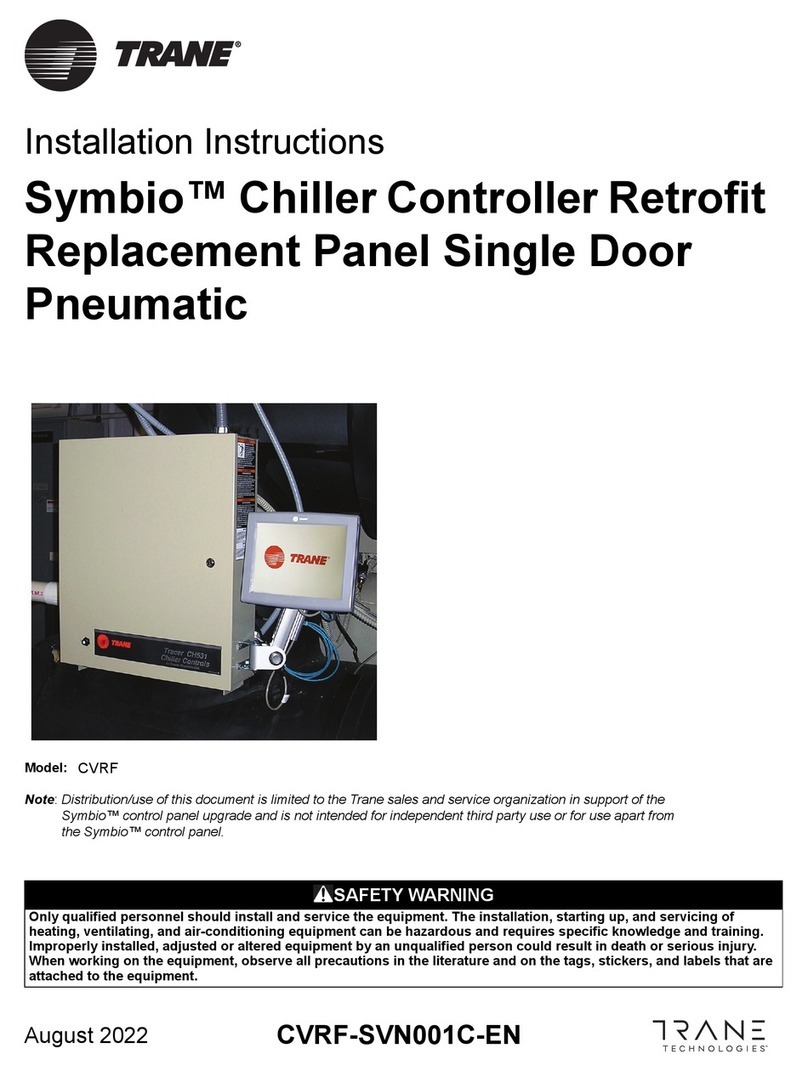
Trane
Trane Symbio CVRF installation instructions
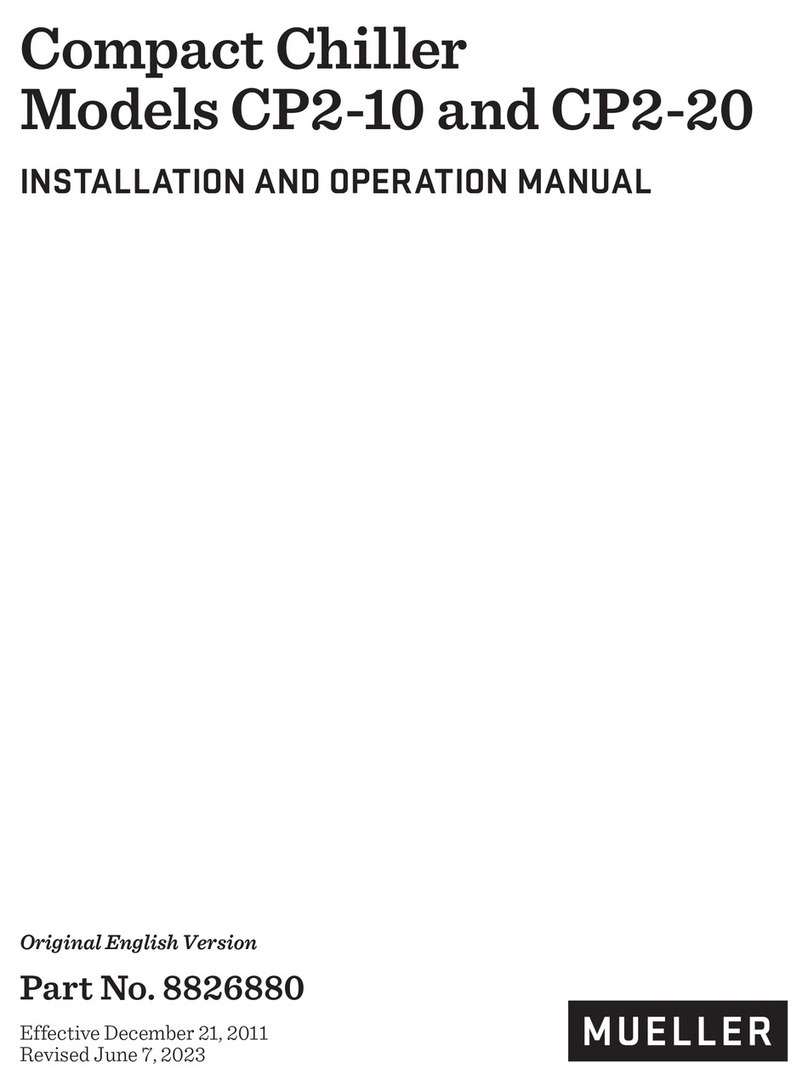
Mueller
Mueller CP2-10 Installation and operation manual
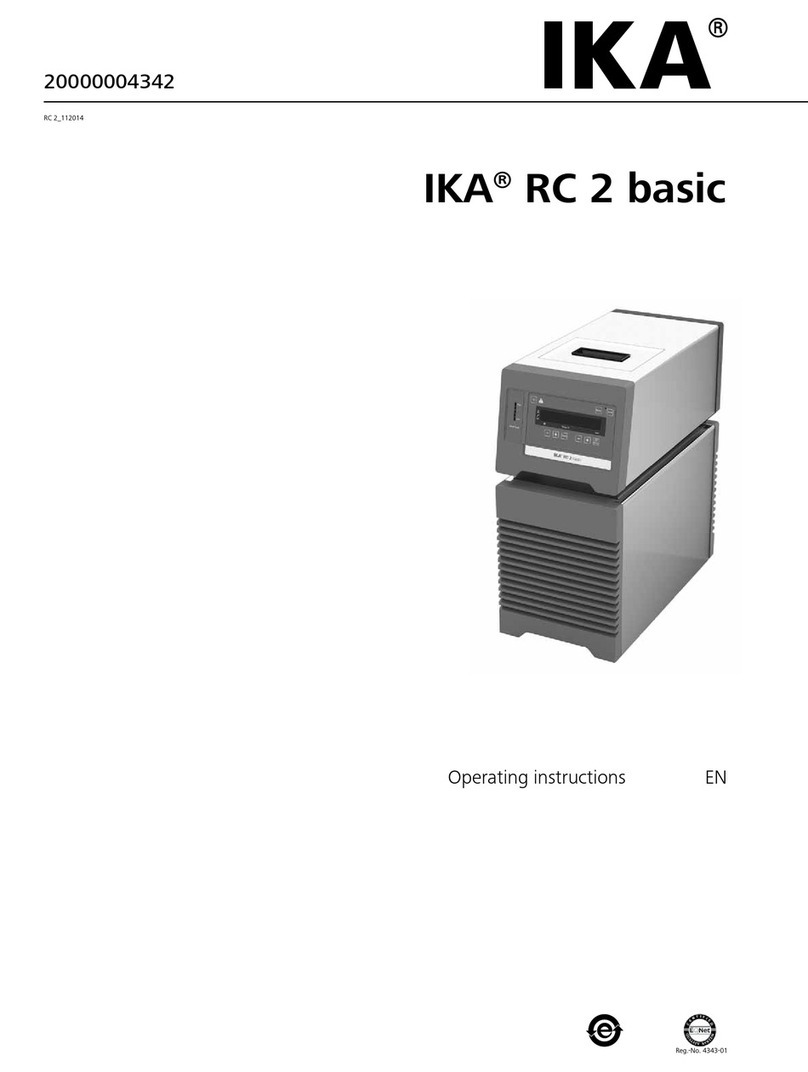
IKA
IKA RC 2 basic operating instructions
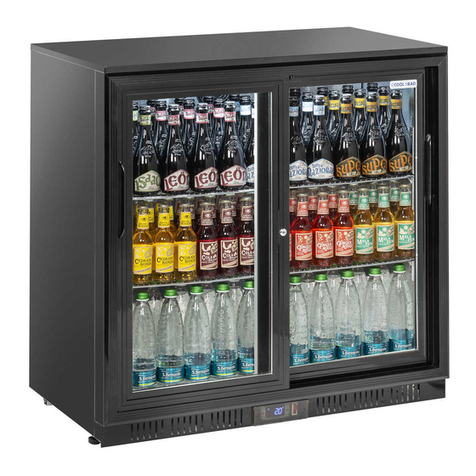
COOL HEAD
COOL HEAD BBC138 instruction manual

Nibe
Nibe CLIMA COOL UCA 20 Installation, operation & maintenance manual

Elkay
Elkay HRC4-191B installation instructions
